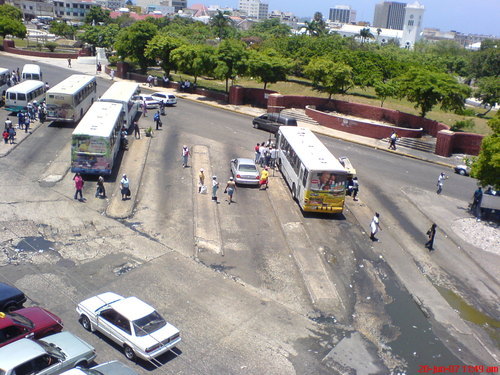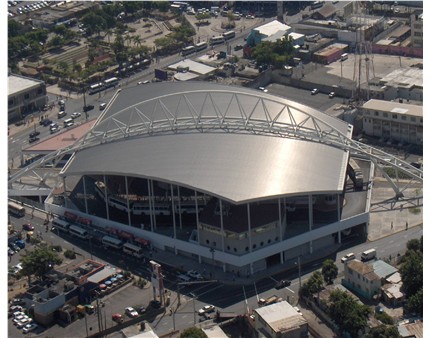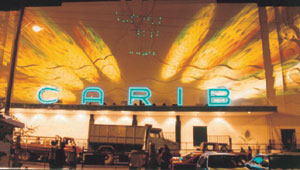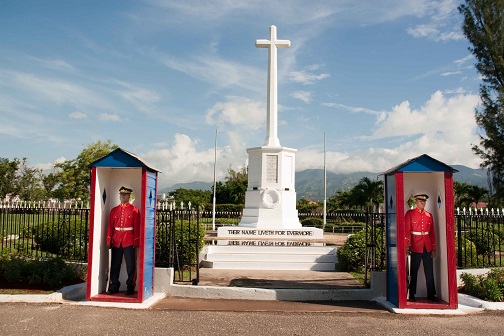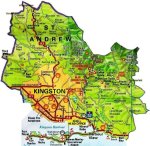Kingston Jamaica
The Capital of Jamaica
Wanna share something Jamaican with us? Share Your Submission HERE!!
CARE to SHARE???... Share this awesome content with your friends now...
Kingston Jamaica is the Capital of Jamaica and it is located on the southeastern end of the island and it boasts a population of approximately 96,052 (as of 2001).
There are a number of landmarks and historical sites that are located in this little city.
The Kingston Harbour is one of those sites. It is the seventh largest harbour in the world and is considered one of the finest anchorages.
Kingston is sheltered by the mountains from the cold northerns and northeast trades.
This protection from winds implies a rain shadow effect, however, Kingston suffers from rainfall unreliability.
Kingston Jamaica's Rich History
The original section of the city of Kingston was laid out about some three hundred years ago to house survivors of the devastating 1692 massive earthquake that destroyed Port Royal.
At that time, since Jamaica had no governor, an Advisory Council decided to buy about two hundred acres of the Crawle to establish a new town. This new town was bounded on the south by Harbour Street. East, West and North Streets defined the remainder of Kingston and in later centuries these borders would extend in all directions.
The original grid pattern of Kingston Jamaica remains the same today with the exception of a few additions. Most of the early streets were named after the men who were councillors at the time of the founding of the town.
In the midst of these streets, an open square was left as the Parade. Early settlement was confined to the area below Parade. The West was near the swamps and regarded as unhealthy and was therefore the least desirable area.
The most popular streets among the early settlers were Church, Harbour and Orange Streets and those around the Parade. Here the settlers lived upstairs their business places. Behind these houses were the YARDS where slaves and poor people lived.
The Capital of Jamaica, Kingston, developed at a phenomenal rate and soon became the centre of trade and commerce on the island. The population of Kingston grew to such an extent that it spilled over in the north into St. Andrew.
Somewhere in the mid-eighteenth century the Governor of Jamaica, Admiral Charles Knowles at the time, sought to have the capital city of Jamaica removed from Spanish Town to Kingston...
...Spanish Town had been the capital of Jamaica for two hundred and thirty years.
His attempt proved abortive as in 1758, it was announced on October 3 by his successor Henry Moore that the King had refused to approve the Bill making Kingston the capital city of Jamaica.
It was not until 107 years later when, as part of radical changes being made as a result of the Morant Bay rebellion, Sir John Peter Grant orchestrated the relocation of the capital from Spanish Town to Kingston.
Get a detailed view of the Map of Kingston Jamaica HERE...
Main Centers In Kingston Jamaica
Down Town Parade
In the centre of Kingston city is a Park which was originally called The Victoria Park after Queen Victoria. It was renamed the St. William Grant Park in 1977, after the noted labour leader and Black Nationalist.
In the original plan of the City, Parade served as a drilling ground for the militia as well as a promenade for citizens.
Public hangings, as well as parades for ceremonial occasions, used to be carried out in Parade. Today it serves as a terminus for buses coming from all over the island.
The Ever Busy Cross Roads

Cross Roads was formerly known as Montgomery Corner. This was named after a Lieutenant Montgomery, who was allegedly thrown by his horse and dragged to that spot where he died.
A clock tower, erected to the memory of service men from Kingston and St. Andrew who died in the Second World War, marks the heart of Cross Roads.
Today it's as busy as ever with a vast amount of businesses, including the ever famous Carib Cinema.
Half Way Tree
Half Way Tree (HWT) is a busy road junction and commercial centre that originated as the principal crossroad village of the parish of St. Andrew.
It got its name from the huge cotton tree that was standing there when the Spaniards first arrived and which died of old age in the 1870s.
The tree stood near to the Parish Church at the junction of important roads between Spanish Town and downtown Kingston as well as roads leading from the rural parishes of St. Andrew and St. George (now Portland) and St. Mary.
New Kingston Jamaica - The Hip Strip
New Kingston started out as the Knutsford Park Race Track. When the race track closed down, the area remained as a large, dusty vacant lot on which learner drivers practiced reversing and parking skills.
Development of New Kingston started in earnest shortly after Jamaica gained its Independence in 1962. Today, New Kingston is a centre of commerce, filled with office complexes, stores and restaurants.
PLACES OF INTEREST IN KINGSTON JAMAICA
The Ward Theatre
The Ward Theatre was presented as a gift to the City of Kingston in 1912 by Colonel Charles Ward who was then the Custos of Kingston. The Theatre was once the home of the Jamaican Pantomime which was staged every year in seasons beginning on Boxing Day (December 26).
Kingston Parish Church
The Kingston Parish Church was erected around the year 1911 on the foundations of the original church and is an attractive building.
This church is also known as “Parish Church of St Thomas the Apostle”.
The
present structure (with the exception of the tower) is similar in
design to the original building, which was destroyed in the devastating
earthquake of 1907. Read more here>>
Carib Cinema
When the Carib Cinema first opened in April 1938, it was the largest building of any kind on the island of Jamaica. Its huge interior measured one million cubic feet.
The 1,750 seats were divided among the orchestra, balcony and a small mezzanine that was situated along the right wall. In 1997, the interior of the Carib was completely destroyed in a fire that started in the ceiling. The exterior walls were saved and now the Carib Cinemas boasts FIVE theatres and is now called Carib 5. It is operated by the Palace Amusement Company Ltd.
Port Royal
Port Royal has such a rich history that I think I will just give you a piece of the details and explain in more details on it's own page.
Here are some general details about the landmarks found in Port Royal:
Fort Charles was built by the British in 1656. St. Peter’s Church was donated by Sir Henry Morgan and Admiral Nelson’s Quarter Deck is where the famous British naval hero kept watch over the harbour.
The Little Theatre - Kingston Jamaica
Located on Tom Redcam Drive, Kingston, this theatre was built in 1961 through the efforts of the Little Theatre Movement (LTM) headed by Henry and Greta Fowler.
The LTM was founded in 1941 and since then, has been a vital part of Jamaica’s cultural development. It is now responsible for staging the annual Pantomime.
The Little Theatre is in continuous use for dramatic productions and for the annual Season of Dance put on by the National Dance Theatre Company (NDTC). It has given birth to a Little Little Theatre used for popular theatrical productions.
The National Stadium and Arena
Jamaica’s National Stadium is home to several local and international sporting events. The Stadium was opened in 1962 to mark Jamaica’s Independence. The historic first raising of the Jamaican flag being the first public event held in the Stadium.
The National Arena, which is a part of the Stadium complex, was built in 1966 and is a major venue for indoor sporting events as well as other forms of entertainment.
Of particular interest is the statue at the entrance to the Stadium. This statue is a composite of the athletes who formed Jamaica’s relay team which won a gold medal in the 1952 Olympic Games in Helsinki; a proud historic moment.
Gordon House
Jamaica’s House of Representatives meets at Gordon House, which is located at the corner of Duke and Beeston Streets in Kingston Jamaica. Built in 1969, Gordon House is named after one of Jamaica’s national heroes, George William Gordon.
National Heroes Park
This park, which used to be known as the Kingston Race Course, was renamed the George VI Memorial Park then later the National Heroes Park. Several monuments have been erected here in honour of the island’s National Heroes. The road surrounding this park has been named National Heroes Circle.
So there are a number of landmarks, historic sites as well as booming and budding business ventures and families in Kingston Jamaica. Visit the Capital of Jamaica, Kingston city, and experience for yourself why it is the Capital of Jamaica.
Sources
Jamaica Information Service, Kingston. Kingston: Jamaica Information Service, (Parish Profiles), 1991.
Map of Jamaica, 1895
Senior, Olive, Encyclopedia of Jamaican Heritage. St. Andrew, Jamaica: Twin Guinep Publishers Ltd., 2003
RELATED PARISH PAGES
CARE to SHARE???... Share this awesome content with your friends now...
If you found this page useful, please feel free to subscribe to my weekly newsletter, The Jamaica Land We Love Digest.
It gives you information every week about the new information that I have added to the site, including any new developments and great Jamaican stories from Jamaicans and lovers of Jamaica worldwide!

NEW!! Comments
Have your say about what you just read! Leave me a comment in the box below.
Other Great Articles You Might Have Missed
